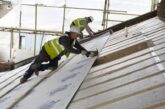
The UK construction industry is stood at the threshold of a new era with the update on the Future Homes and Buildings Standards 2023. Ethan Wadsworth, Sales and Marketing Director at DiscreteHeat, explains what’s in store.
As detailed in the government’s consultation, these standards herald a significant transformation in building practices, with an emphasis on reducing carbon emissions and enhancing energy efficiency. This article delves into the key aspects of these standards, offering a concise overview for professionals in the construction sector.
Maintaining Insulation Standards
A pivotal aspect of the new standards is the approach to insulation. In a move that balances innovation with practicality, the insulation levels in the Future Homes Standard remain largely consistent with previous building standards. This decision underpins a commitment to energy efficiency without imposing drastic changes in building practices. The specific U-Values, heating and hot water strategies are outlined in the below extract:
The Shift to Low-Carbon Heating
Perhaps the most significant shift is the move away from fossil fuels for heating. The standards explicitly rule out gas boilers, hydrogen boilers, and hybrid systems in new homes, emphasizing air-to-water heat pumps as the primary method for heating and hot water provision. This change is rooted in the UK’s broader commitment to reducing carbon emissions and aligns with global environmental goals.
Evaluating Heating System Efficiency
The standards also address the efficiency of different heating systems. Direct electric heating systems, such as infra-red electric panels, are now seen as less efficient due to their Coefficient of Performance (COP) of 1.0, which pales in comparison to the Seasonal

Coefficient of Performance (SCOP) of 3.5 common with heat pump systems. This analysis clearly indicates a preference for heat pump systems in future building designs.
Challenges with Emitter Selection
With the adoption of low-temperature systems like heat pumps, the selection of appropriate emitters becomes crucial. Traditional radiators, for instance, would need to be significantly larger, raising concerns about space utilization and aesthetics. Underfloor heating, while performance-efficient, is often avoided by developers due to the additional floor buildup, longer construction times, and the environmental impact of the concrete used in these systems.
ThermaSkirt: The Low Temperature Solution
In response to these challenges, ThermaSkirt Skirting Board Heating emerges as a UK made innovation. This system provides a middle ground, combining the benefits of radiators and underfloor heating. ThermaSkirt distributes heat at a low level around the room, operating effectively at low temperatures typical of heat pump systems. Notably, it does not compromise on space and aesthetics, a critical consideration in modern home design. The efficacy of ThermaSkirt has been demonstrated in trials by Barratt Developments in conjunction with a Vaillant Arotherm heat pump, even in temperatures below -10°C.
Looking Ahead
The Future Homes and Buildings Standards 2023 mark a significant step towards sustainable construction in the UK. For building consultants, architects, and developers, these standards necessitate a re-evaluation of traditional building practices and an adaptation to more sustainable, energy-efficient technologies. While the challenges are apparent, particularly in terms of heating system specifications and emitter selection, the opportunities for innovation and environmental stewardship are equally significant.
As the industry adapts to these changes, the emphasis will increasingly be on developing solutions that not only meet regulatory requirements but also address practical considerations in building design. The role of innovative products like ThermaSkirt will be crucial in this transition, providing effective, efficient, and aesthetically pleasing heating solutions.
In summary, the Future Homes and Buildings Standards 2023 consultation represents a critical juncture for the UK construction industry, offering a roadmap for a more sustainable and environmentally responsible future. As we move forward, it is imperative that all stakeholders in the construction sector engage with these standards, understanding their implications and exploring new avenues to meet these challenges head-on.
For detailed information on the Future Homes and Buildings Standards 2023 and to participate in the consultation, visit the UK government’s official site click here
To view details of ThermaSkirt Skirting Board Heating click here







